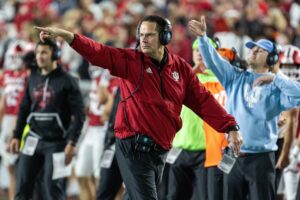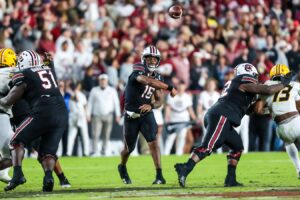A Deeper Look into the Transfer Portal
Like other sources that cover college football, we have been following and reporting on the changing landscape of college football. From the transfer portal to NIL compensation, things have certainly changed over the last five years. Whether we bemoan the changes or not, most are here to stay. Their impact, however, may normalize as the years pass. Time will tell. For now, we now have the first three full years of data, and we have poured over it closely. With that, we are taking a deeper look into the transfer portal.
How the Portal Works
The portal opened on October 15, 2018. Once established, any player who wanted to enter it simply went to his school’s designated compliance officer or administrator, communicated his intention, and his name was added to the database. Once he entered, he still had the option to remain at his current school, that is, of course, if his current school allowed it. The current school is not obligated to retain the player, and the current school may, in some cases, rescind the player’s scholarship.
Beginning with the 2021 college football season, the NCAA enacted a one-time transfer exception to portal entrants. Previously, the general rule was that players who sought to transfer from a four-year institution (in other words, not a junior college or school otherwise outside the NCAA’s reach) had a one-year residency requirement. That rule required a student-athlete to sit out of in-game competition for a full season after transferring.
During the COVID pandemic, the NCAA temporarily relaxed that requirement. Then, they approved a permanent one-time transfer exception. Provided that a student-athlete retained eligibility, including academic eligibility, he could play immediately if he did not previously transfer from one four-year institution to another. Importantly, this also applies to graduate transfers. Previously, the one-time transfer exception only applied to graduate transfers with remaining eligibility. Now, it applies to all student-athletes. But graduate students must still request a waiver if they are transferring between four-year institutions for a second time.
How the Data Works
The portal itself is not open to the public. Certain media sources and designated personnel at each NCAA institution can register for access. For the time being, the single best source to which the rest of us can look is housed by 247Sports. They have a Transfer Portal database here. To be sure, other sources collect and publish this data, but, nationwide, they coalesce that data in the most accessible way.
There is sometimes confusion in discussions concerning transfers. Intuitively, some like to look at the number of transfers in a calendar year. The 247Sports database does not work that way, nor should it. A player can transfer into a school as late as late August and still play in games for the new school that season. As a result, 247Sports groups transfer data by school and by class year.
In other words, if a player enters the portal any time after late August 2020, for example, and before late August 2021, the player is identified in the 2021 transfer class. Why? Because, like high school players signing in December 2020 or during the Late Signing Period in 2021, they are first eligible to compete for their new school in the 2021 season.
In general, we find it best to analyze a transfer class that is already complete. The 2022 transfer class is only now underway in earnest. Outside of in-season transfers (that some schools have a lot of for various reasons), the majority of transfers seem to enter the portal at some point between the conclusion of bowl season and within a few weeks after the conclusion of Spring camp.
Looking at the Totals
As we said, we look here to the first three transfer portal classes, which are the transfer classes of 2019 through 2021. Each class is complete. We know both the number and the final destinations of entrants in those years. With that behind us, we are taking a deeper look into the portal. Specifically, we focus on the Power Five schools plus Notre Dame and BYU (the Power Five Plus institutions). We excluded players who entered the portal to remain at their current school (fewer than 1% of all entrants). We also excluded the few players who entered the portal but declared for the draft instead of transferring.
Some schools fare better than others. For example, 10 Power Five schools had 25 or fewer transfers in those three classes. That represents the 15% of schools with the fewest entrants in the first three years. The Power Five Plus school with the fewest transfers in the first three years was BYU with just 13. Only Ohio State (14) joined BYU with fewer than 15. Stanford also lost just 17. Meanwhile, Wisconsin (18), Pitt (18), Northwestern (19), and Baylor (19) represent the only other Power Five Plus schools with fewer than 20. Clemson (21), Washington (22), and Iowa State (23) round out the top ten.
On the other hand, some schools fared worse. Indeed, ten Power Five Plus schools saw 45 or more transfer portal entrants in those same three classes. This represents your bottom 15%. Nebraska and Tennessee hold the top spot here, with each surrendering 57 players. North Carolina finished behind them with 53, and Arkansas (52) and Virginia Tech (51) trailed closely behind. Both Maryland and Michigan saw 50 players transfer. The lowest three here were Arizona State (48), Rutgers (48), and Texas A&M (45).
League-Wide Averages
Across all of the Power Five Plus schools, each team lost an average of 11 players per year to the portal. We did not see much separation between the conferences either. The Big Ten led the way with 502 total portal entrants. On average, each school surrendered 36 (12 per year) to the portal. The SEC finished just behind with 500 total entrants. In round numbers, their averages (36 total, 12 per year) matched the Big Ten.
Behind those two, the ACC finished third with 450 total portal entrants. Each school averaged 32 players surrendered to the portal, for an average of just under 11. The Big 12 matched those averages, also will 11 players per team per year, though its total entrants were lower since the conference fields only ten teams. The fewest number of transfers came out of the Pac-12. In total, their teams averaged 10 players per team per year lost to the portal.
Where Do They Go?
As we take a deeper look into the portal, we would be remiss if we did not also look closely at where the portal takes players. Jokes aside, the portal certainly does not take players into the ether. They end up somewhere. In total, just 26% of all Power Five Plus players to enter the portal in the first three years transferred to another Power Five Plus institution.
Of that 26%, of course, even fewer made an impact–immediate or otherwise–at their destination school. The precise figure depends on a subjective measure of impact. Suffice it to say, though, that number is less than half. That means that well under 15% of all Power Five Plus athletes to enter the portal find success at another Power Five Plus school. In round figures, that represents three athletes out of every 20 portal entrants. Those are pretty low odds indeed.
In this measure, however, we do find a bit more separation between the conferences. Just shy of 30% of SEC transfers end up at another Power Five Plus school. Perhaps surprisingly, the Pac-12 falls into second place here, just barely behind the SEC with 29% of its transferring athletes enrolling at another Power Five Plus school. The Big Ten lags behind in third with 24% of its athletes meeting this mark. The Big 12 sees 22% of its transferring athletes landing at other Power Five Plus schools. Finally, the ACC trails behind with just under 21% of its portal entrants hitting this threshold.
Who Feeds Whom?
Popular belief says that the lower-tier schools will feed the top schools through the portal. Outside of the top two-dozen or so athletes per year, though, this is not the case. Indeed, the schools with the largest percentage of their transferring athletes landing at another Power Five Plus school come from this upper tier.
Ohio State leads the way with nearly 79% of its portal entrants heading off to other Power Five Plus schools. Only Clemson joins the Buckeyes in that 70% threshold (74%). USC is the only other school with more than 60% (65%). Only two other schools see more than 50% of their transfers head to other Power Five Plus schools. Those are Alabama (55%) and Notre Dame (52%).
Perhaps understandably, since pretty much every school outside of the yearly top 15 recruiting teams battle for about 130 remaining blue-chip prospects, the lower-tier schools seek to add the talent they missed on out of high school through the portal. As a result, it ends up being the top-tier schools that feed more players to the lower tiers. That said, the elite schools are certainly not shy about adding a few critical pieces they may have overlooked the first time around.
Where Do We Go from Here?
One fact remains true regardless of the establishment of the portal. There will always be student-athletes who realize that they just are not going to get playing time at a Power Five Plus school. Maybe those kids understand they are not playing for a professional contract. A percentage of athletes will always believe that transferring “down” (to a G5 or FCS school) best suits their goals. That happened before the portal. If the portal closes tomorrow, it will still happen.
That said, we do wonder whether the players who think the “grass is greener” and that their Power Five Plus school just overlooks their talent or uses it incorrectly where others would not reduce in number as we see more data and hear more stories about players finding their way out of the game with transfer mistakes. For every action, there is an equal opposite one. Perhaps the rubber band snaps back.
On the other hand, perhaps the trend increases further as different state enacts their own NIL laws. As we wrote in our NIL analysis series, student-athletes could essentially shop their services and balance their desired schools and coaches with more preferable conference rules or state laws that allow them to improve their NIL earnings and the tax implications of those earnings. If we remain without a uniform set of rules, this will certainly begin playing a heavy factor in transfer portal decisions.






